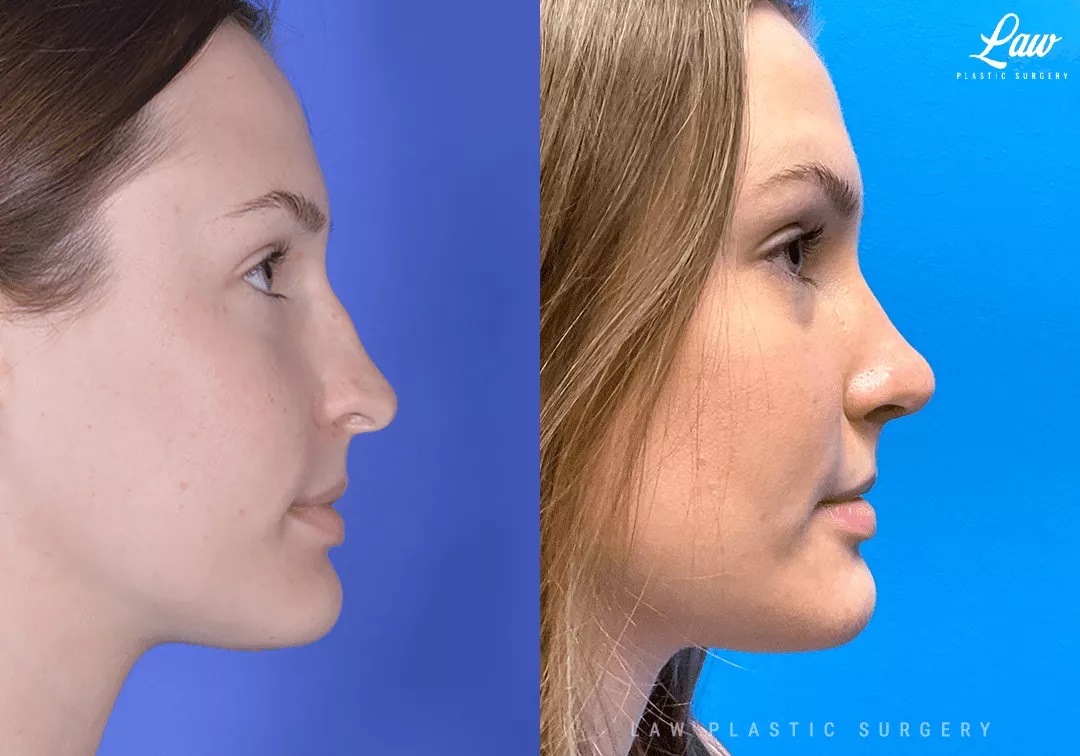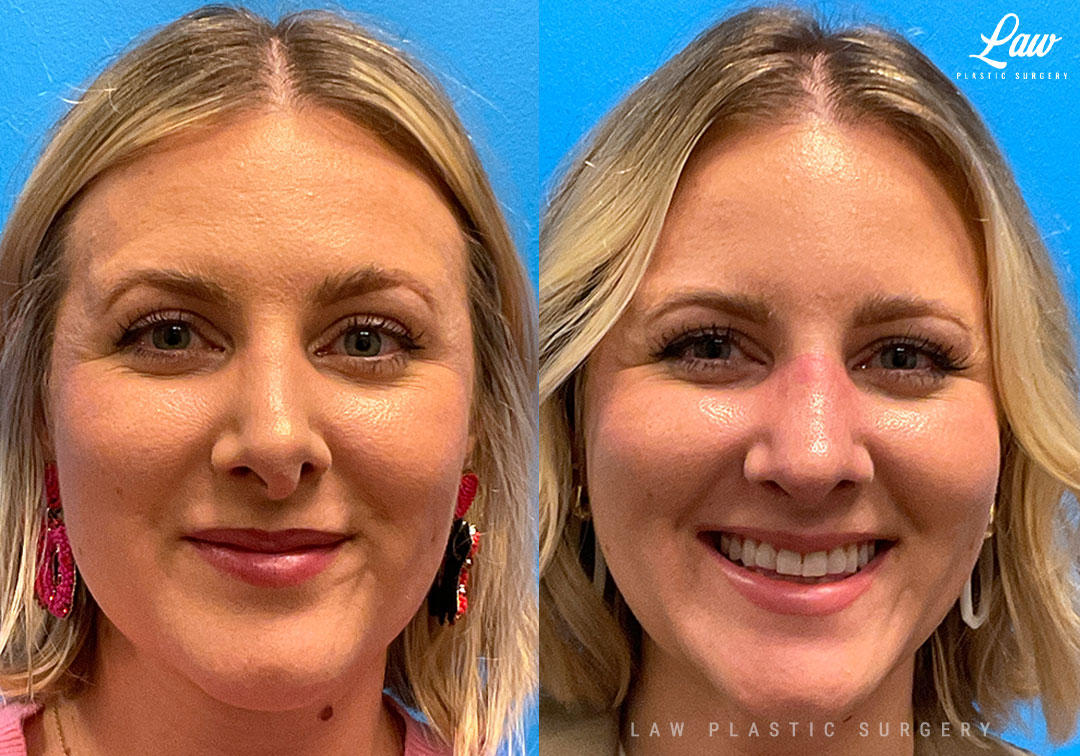Septoplasty Before & After Photos
Dr. Huay-Zong Law – Fort Worth Septoplasty Specialist
Seeking septoplasty in Fort Worth? Dr. Huay-Zong Law offers specialized surgical care to address your nasal issues. If you are struggling with nasal obstruction or recurrent sinus infections, scheduling a consultation with Dr. Law could be your first step towards a better quality of life. Don’t let a deviated septum hold you back—embrace the opportunity for improved health and well-being.
Things To Know About Septoplasty
- A deviated septum can cause nasal obstruction and lead to complications like sleep issues, sinus infections, and overall discomfort.
- Septoplasty is a surgical procedure that corrects a deviated septum, significantly improving airflow and quality of life for suitable candidates.
- Proper preparation and postoperative care are essential for a successful recovery from septoplasty, including medication management and lifestyle adjustments.
Understanding the Nasal Septum and Deviations
The nasal septum is a vital structure within our nose, formed by a combination of bone and cartilage that divides the nasal cavity into two nostrils. When properly aligned, it ensures smooth airflow and supports the overall function of the nasal passages.
However, a deviated septum occurs when the bone and cartilage are misaligned, leading to issues such as nasal obstruction and difficulty breathing through the nose. This condition can arise from various causes, including genetics, congenital conditions, or trauma to the nose. The consequences extend beyond just breathing difficulties; excessive mouth breathing can lead to problems like daytime sleepiness, bad breath, and even changes in jaw development.
Moreover, a deviated septum can interfere with the drainage of the sinuses, potentially causing recurrent sinus infections. Understanding the structure and function of the nasal septum is the first step towards recognizing and addressing the problems associated with its deviation.
Diagnosing a Deviated Septum
Diagnosing a deviated nasal septum begins with a thorough consultation with Dr. Huay-Zong Law. During this consultation, patients are asked about:
- Their nasal obstruction
- Its duration
- Any history of nasal trauma or surgeries
- Previous treatments
Dr. Law’s comprehensive approach ensures that all potential factors are taken into account.
The physical examination involves inspecting the nose’s general appearance and the position of the nasal septum using a bright light and nasal speculum to expose any abnormalities. Sometimes, Dr. Law may also evaluate the nasal tissues before and after applying a decongestant to assess the severity of the deviation.
In certain cases, further diagnostic tools like CT scans or sleep studies may be required to get a complete picture of the septum’s condition.
The Septoplasty Procedure
Septoplasty is the preferred surgical treatment for correcting a deviated nasal septum to improve airflow. This procedure is typically performed under general anesthesia, ensuring the patient remains comfortable and unaware during the surgery. The duration of a septoplasty can range from 30 to 120 minutes, depending on the complexity of the case.
During the procedure:
- Small incisions are made within the nasal cavity to access the septum.
- The surgeon removes or adjusts the deviated cartilage to straighten the nasal passages.
- In more complex cases, an open septorhinoplasty might be required, which involves further cartilage grafting and suturing to reinforce the nasal structure.
Once the septum is corrected, the incisions are closed, and the nasal passages are supported with splints or packing to aid in healing. This meticulous process ensures that the nasal airway is significantly improved, providing long-term relief from the symptoms of a deviated septum.
Ideal Candidates for Septoplasty
Not everyone with a deviated nasal septum needs surgery, but certain symptoms and conditions make some individuals ideal candidates for septoplasty. Patients with significant nasal airway obstruction, chronic sinusitis, or recurrent sinus infections should consider this procedure. Chronic sinus infections, in particular, often necessitate septoplasty in coordination with sinus surgery.
Other suitable candidates include those experiencing:
- Facial pain
- Headaches
- Poor sleep
- Breathing difficulties due to a deviated septum
- Frequent nosebleeds
- A diminished sense of smell
These are indicators that septoplasty might be beneficial.
Additionally, individuals who have previously broken their nasal bones or septum are prime candidates for reconstructive nasal surgery.
Benefits of Septoplasty
The primary goal of septoplasty is to enhance breathing by correcting the nasal septum. Many patients notice a significant improvement in their nasal breathing and a reduction in snoring within a few weeks after the procedure. This improvement in airflow can lead to better sleep quality, alleviating issues like snoring and sleep apnea.
Beyond breathing, septoplasty often results in a significant reduction in nasal discomfort and a long-lasting solution to the problems associated with a deviated septum. Patients typically experience an overall enhancement in their quality of life, making septoplasty a worthwhile investment in their health and well-being.
The Septoplasty Procedure With Dr. Huay-Zong Law
Dr. Huay-Zong Law is renowned for his expertise in septoplasty, ensuring that each procedure is tailored to the patient’s specific needs. The surgery typically involves making an incision inside one nostril to access and correct the deviated septum. In more complex cases, a small incision across the columella might be necessary to achieve the best results.
Dr. Law’s meticulous approach often includes additional procedures like turbinate reduction to further improve airflow. Key details of the procedure include:
- It is an outpatient procedure, allowing patients to usually return home the same day, making the process convenient and efficient.
- The entire procedure is performed under general anesthesia.
- The duration can last between 30 to 120 minutes, depending on the complexity.
During the Procedure
During septoplasty:
- General anesthesia is administered to ensure the patient is comfortable and unaware during the surgery.
- The surgeon carefully separates the mucosal lining covering the septum to access the deviated areas.
- This involves lifting the mucosa, a thin membrane, to reshape the underlying cartilage and bone.
Once the deviated portions are corrected, the mucosal lining is repositioned and sutured back into place. Splints or packing may be placed inside the nose to support the healing process. The procedure is designed to straighten the septum and enhance nasal function, providing long-term relief from breathing problems.
Preparing for Septoplasty
Proper preparation is crucial for a successful septoplasty. Dr. Huay-Zong Law may provide specific instructions regarding fasting before the procedure to ensure patient safety. Patients may also need to stop taking certain medications like aspirin or Ozempic before surgery to reduce the risk of excessive bleeding.
To ensure patients are in the best possible condition for their procedure, it is essential to:
- Inform the surgeon about all medications, including over-the-counter drugs and supplements.
- Avoid smoking before and after surgery.
- Avoid recreational drug use before and after surgery.
These preparatory steps are crucial for optimal healing.
Recovery Process and Postoperative Care
The recovery process after septoplasty involves:
- Managing mild swelling, bleeding, and discomfort.
- Expecting mild bloody drainage in the first 24 to 72 hours post-surgery.
- Managing pain relief with acetaminophen.
- Avoiding aspirin or anti-inflammatory drugs to reduce the risk of excessive bleeding.
Patients should follow these post-surgery care instructions:
- Sleep with their head elevated for 2-3 days following surgery to minimize swelling.
- Avoid heavy lifting or strenuous activities for at least one week after surgery.
- Resume usual activities over 4-6 weeks, depending on the extent of the surgery and the types of activities.
- Keep the nasal passages moist with saline mist spray several times daily for comfort and healing.
In case of excessive pain or other concerning symptoms, patients should contact their physician immediately. Following these postoperative care guidelines ensures a smooth recovery and optimal results from the septoplasty.
Combining Septoplasty with Other Procedures
Combining septoplasty with other surgical procedures can enhance both the functionality and aesthetics of the nasal structure. A common combination is septorhinoplasty, which addresses both cosmetic and functional nasal issues. This combined surgery can effectively harmonize the results, ensuring that functional improvements do not detract from the nose’s appearance.
Undergoing septorhinoplasty offers the benefit of a single recovery period, reducing overall downtime compared to having separate surgeries. Areas often addressed in this combination include reducing a dorsal hump, refining a bulbous tip, and improving tip definition and rotation. This holistic approach ensures that patients achieve both improved breathing and a more aesthetically pleasing nose.
Benefits of Septoplasty
Septoplasty can significantly enhance airflow through the nasal passages, leading to:
- Improved breathing efficiency
- A marked improvement in overall quality of life, with many individuals experiencing enhanced day-to-day activities
- Alleviation of associated issues like snoring and sleep apnea, resulting in better sleep quality
In addition to better breathing, septoplasty often results in a decrease in the frequency of sinus infections, providing long-term relief from nasal discomfort. The combined benefits of improved nasal function and overall quality of life make septoplasty a highly beneficial procedure for those dealing with a deviated nasal septum.
Scheduling A Septoplasty Consultation with Dr. Law
If you are looking for an experienced, compassionate, board-certified, and highly skilled plastic surgeon, contact Law Plastic Surgery today. Dr. Huay-Zong Law is dedicated to providing each of his patients with exceptional care and natural-looking results.
Law Plastic Surgery is conveniently located at 7777 Forest Ln, C-528, Dallas, TX 75230. To schedule an appointment, call (214) 241-1997. Taking the first step towards better breathing and improved quality of life is just a phone call away.
Choosing Dr. Law For Your Septoplasty
In summary, septoplasty offers a transformative solution for those suffering from a deviated nasal septum. By correcting the nasal septum, patients can experience enhanced breathing, improved sleep quality, and a significant reduction in nasal discomfort. Dr. Huay-Zong Law’s expertise ensures that each patient receives personalized care and exceptional results.
Frequently Asked Questions
What is septoplasty?
Septoplasty is a surgical procedure designed to correct a deviated nasal septum, enhancing airflow and significantly improving quality of life.
Who is an ideal candidate for septoplasty?
An ideal candidate for septoplasty is someone experiencing significant nasal airway obstruction, chronic sinusitis, or recurrent sinus infections due to a deviated septum, resulting in facial pain and breathing difficulties. This procedure can effectively alleviate their symptoms and improve quality of life.
How long does the septoplasty procedure take?
Septoplasty usually takes between 30 to 120 minutes, depending on the complexity of the surgery required.
What can I expect during the recovery process?
During the recovery process, you can expect mild swelling, bleeding, and discomfort. It’s important to avoid heavy lifting, keep your head elevated, and use saline mist spray to maintain moisture in your nasal passages.
How do I schedule a consultation with Dr. Huay-Zong Law?
To schedule a consultation with Dr. Huay-Zong Law, simply call Law Plastic Surgery at (214) 241-1997.
Related Procedures




